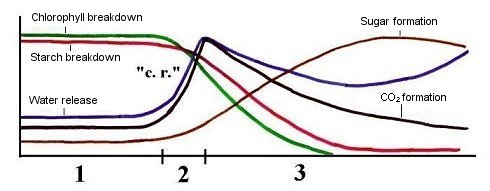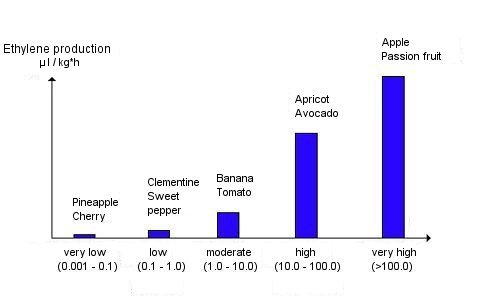| Ethylene production rate [µl/(kg*h)] |
Products |
| Zero: 0 |
Chinese artichoke, Japanese radish, prickly pear, Florence fennel, cassava, pak-choi cabbage, cranberry, black salsify |
| Very low: 0.01 - 0.1 |
Pineapple, artichoke, cauliflower, broccoli, watercress, mushroom, chicory, Chinese cabbage, date, endive, pea, Jerusalem artichoke, grapefruit, curly kale, ginger, carrot, potato, cherry, garlic, celeriac, kohlrabi, lime, sweetcorn, mandarin, horseradish, orange, parsnip, parsley root, chanterelle, leek, radish, rhubarb, Brussels sprout, beetroot, red cabbage, turnip, green cabbage, asparagus, spinach, rutabaga, celery, sweet potato, tangerine, taro, grape, white cabbage, lemon, onion |
| Low: 0.1 - 1.0 |
Winter cherry, aubergine, egg-plant, berries, bitter squirting cucumber, Seville orange, bean, clementine, persimmon, iceberg lettuce, baby sweetcorn, pomegranate, guava, cucumber, starfruit, kiwifruit, coconut, cabbage lettuce, kumquat, pumpkin, limequat, olive, sweet pepper, chili pepper, quince, garden radish, satsuma, watermelon, courgette, zucchini |
| Moderate: 1.0 - 10.0 |
Banana, fig, feijoa, honeydew melon, Jack fruit, lychee, mango, mangosteen, plum, tomato |
| High: 10.0 - 100.0 |
Apricot, avocado, tamarillo, pear, papaya, peach/nectarine |
| Very high: > 100.0 |
Apple, cherimoya, passion fruit |
Table 6: Ethylene production of various types of fruit and vegetables;
taken from Alders (with additions) [2]
Fruits may be divided into two categories on the basis of their respiration profile: "climacteric fruits" and "non-climacteric fruits", (see Table 7).
| Climacteric fruits | Non-climacteric fruits |
| Apples | Pineapple |
| Apricots | Blueberries |
| Avocados | Strawberries |
| Bananas | Cucumbers |
| Pears | Limes |
| Figs | Oranges |
| Kiwifruit | Satsumas/mandarins |
| Mangoes | Grapes |
| Papaya | Lemons |
| Passion fruit | |
| Peaches | |
| Plums | |
| Tomatoes |
Table 7: Classification of goods of vegetable origin by respiration behavior
during ripening; taken from Alders [2]
Climacteric fruits display the typical respiration profile, as illustrated in Fig. 79 using bananas as an example, which is associated with high levels of carbon dioxide and ethylene production during ripening. Non-climacteric fruits, e.g. potatoes, root vegetables, strawberries, do not display the increase in respiration rate known as the "climacteric rise"; instead, the respiration rate falls during ripening, with only small amounts of ethylene consequently being produced.

| Figure 79: Ripening of bananas 1 - preclimacteric (green) 2 - climacteric (turners) 3 - postclimacteric (yellow) "c.r." - "climacteric rise" |
When transporting fruit of a single type by container, it must be ensured that the transportable unripe fruit at the preclimacteric stage is not stowed together with fruit in an advanced state of ripeness, because the ethylene released by the ripening fruit causes the unripe fruit to ripen prematurely. If one item of fruit begins to excrete ethylene, a whole container cargo may begin the increase in respiration associated with the climacteric (see turners in cargoes of bananas).
If an on-board porthole system is used, all the fruit in all the containers with which it is connected may then suffer premature ripening, which may amount to as many as 100 metric tons of bananas, for example.
In addition to the increase in respiration, ethylene initiates other normal ripening processes, such as chlorophyll degradation, starch hydrolysis and sugar build-up.
When fruit and vegetables of various types are being transported by container, care must be taken to ensure that the types of fruit and vegetables belong to different categories of ethylene producer, as shown in Table 6 and Fig. 82. Thus, for example, apples, which produce large quantities of ethylene, cause potatoes to germinate prematurely. Cucumbers turn yellow on exposure to ethylene from apples or tomatoes. Table 8 shows the ethylene sensitivity of various types of fruit and vegetables.
| Ethylene sensitivity |
Products |
| Zero | Seville orange, Chinese artichoke, clementine, fennel, kumquat, pak-choi cabbage, chanterelle, cranberry, garden radish, satsuma |
| Low | Pineapple, winter cherry, artichoke, aubergine, egg-plant, berries, bitter squirting cucumber, date, Jerusalem artichoke, fig, feijoa, baby sweetcorn, pomegranate, ginger, prickly pear, starfruit, carrot, cherry, garlic, celeriac, coconut, pumpkin, sweetcorn, cassava, horseradish, sweet pepper, parsnip, chili pepper, parsley root, radish, rhubarb, beetroot, turnip, black salsify, rutabaga, sweet potato, taro, grape, watermelon, onion (dry) |
| Moderate | Tamarillo, bean, mushroom, endive, pea, Jack fruit, grapefruit, guava, potato, cabbage lettuce, lime, lychee, mandarin, olive, orange, leek, asparagus, celery, tangerine, lemon, courgette, zucchini, onion (green) |
| High | Apple, apricot, avocado, banana, pear, cauliflower, broccoli, watercress, cherimoya, chicory, Chinese cabbage, persimmon, iceberg lettuce, curly kale, cucumber, honeydew melon, kiwifruit, mango, mangosteen, papaya, passion fruit, peach, plum, quince, Brussels sprout, red cabbage, spinach, tomato, white cabbage, savoy cabbage |
Table 8: Ethylene sensitivity of various types of fruit and vegetables;
taken from Alders (with additions) [2]
In practice, ethylene formation is prevented to a considerable extent by a specific dormancy temperature together with reduced respiratory activity (see Section 15.2.4.2). On the other hand, this effect may be used to advantage in ripening warehouses to bring about ripening at the desired time by exposure to ethylene.
Measurement of ethylene concentration may be performed using an ethylene monitor (see TIS).
 |
| Figure 82: Ethylene production of fruit and vegetables |